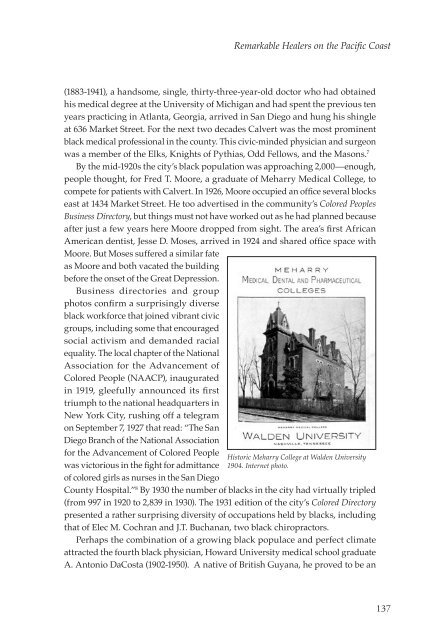Summer 2011, Volume 57, Number 3 - San Diego History Center
Summer 2011, Volume 57, Number 3 - San Diego History Center
Summer 2011, Volume 57, Number 3 - San Diego History Center
Create successful ePaper yourself
Turn your PDF publications into a flip-book with our unique Google optimized e-Paper software.
Remarkable Healers on the Pacific Coast<br />
(1883-1941), a handsome, single, thirty-three-year-old doctor who had obtained<br />
his medical degree at the University of Michigan and had spent the previous ten<br />
years practicing in Atlanta, Georgia, arrived in <strong>San</strong> <strong>Diego</strong> and hung his shingle<br />
at 636 Market Street. For the next two decades Calvert was the most prominent<br />
black medical professional in the county. This civic-minded physician and surgeon<br />
was a member of the Elks, Knights of Pythias, Odd Fellows, and the Masons. 7<br />
By the mid-1920s the city’s black population was approaching 2,000—enough,<br />
people thought, for Fred T. Moore, a graduate of Meharry Medical College, to<br />
compete for patients with Calvert. In 1926, Moore occupied an office several blocks<br />
east at 1434 Market Street. He too advertised in the community’s Colored Peoples<br />
Business Directory, but things must not have worked out as he had planned because<br />
after just a few years here Moore dropped from sight. The area’s first African<br />
American dentist, Jesse D. Moses, arrived in 1924 and shared office space with<br />
Moore. But Moses suffered a similar fate<br />
as Moore and both vacated the building<br />
before the onset of the Great Depression.<br />
Business directories and group<br />
photos confirm a surprisingly diverse<br />
black workforce that joined vibrant civic<br />
groups, including some that encouraged<br />
social activism and demanded racial<br />
equality. The local chapter of the National<br />
Association for the Advancement of<br />
Colored People (NAACP), inaugurated<br />
in 1919, gleefully announced its first<br />
triumph to the national headquarters in<br />
New York City, rushing off a telegram<br />
on September 7, 1927 that read: “The <strong>San</strong><br />
<strong>Diego</strong> Branch of the National Association<br />
for the Advancement of Colored People<br />
was victorious in the fight for admittance<br />
of colored girls as nurses in the <strong>San</strong> <strong>Diego</strong><br />
Historic Meharry College at Walden University<br />
1904. Internet photo.<br />
County Hospital.” 8 By 1930 the number of blacks in the city had virtually tripled<br />
(from 997 in 1920 to 2,839 in 1930). The 1931 edition of the city’s Colored Directory<br />
presented a rather surprising diversity of occupations held by blacks, including<br />
that of Elec M. Cochran and J.T. Buchanan, two black chiropractors.<br />
Perhaps the combination of a growing black populace and perfect climate<br />
attracted the fourth black physician, Howard University medical school graduate<br />
A. Antonio DaCosta (1902-1950). A native of British Guyana, he proved to be an<br />
137







![[PDF] The Journal of San Diego History Vol 52: Nos 1 & 2](https://img.yumpu.com/25984149/1/172x260/pdf-the-journal-of-san-diego-history-vol-52-nos-1-2.jpg?quality=85)

![[PDF] The Journal of San Diego History - San Diego History Center](https://img.yumpu.com/25984131/1/172x260/pdf-the-journal-of-san-diego-history-san-diego-history-center.jpg?quality=85)







